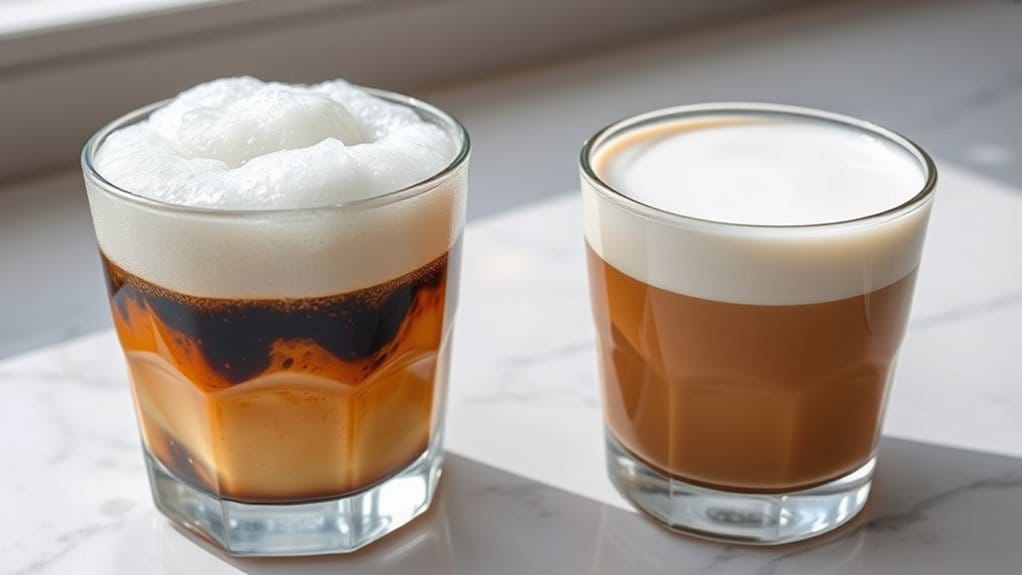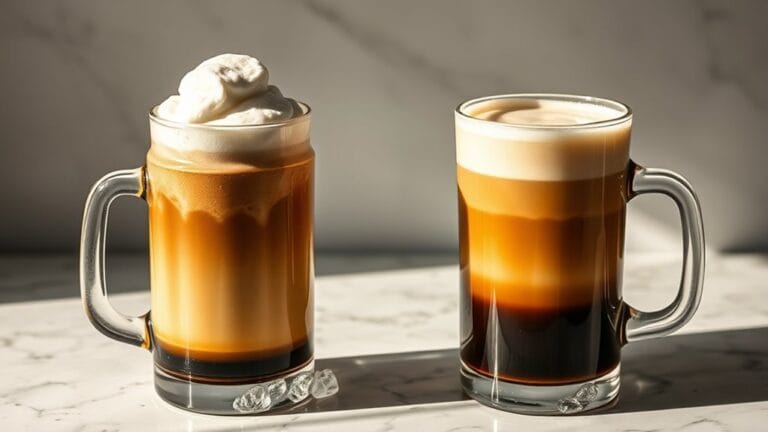Iced cappuccinos and lattes differ in strength, texture, and foam! Cappuccinos pack bold espresso with a 1:1 to 2:1 milk ratio, while lattes dilute espresso more (3:1 to 4:1) for creaminess. Cappuccinos use thick, airy foam matching the espresso volume, creating a fluffy layer, whereas lattes blend smooth foam with milk for a silky sip. Both chill coffee cravings but cater to different moods—adventure in every bubbly gulp or milky relaxation. Hungry for the full scoop? The details get even cooler.
Coffee Base & Espresso Ratio
When comparing iced cappuccinos and lattes, the secret sauce is all in the espresso-to-milk ratio.
Both drinks start with *espresso*, but the iced cappuccino flexes a 1:1 to 2:1 milk-to-espresso ratio—like a coffee boss shouting, “Respect the beans!” It packs a double shot (around 40ml) brewed strong to hold its own against minimal milk. Meanwhile, the iced latte plays it chill with a 3:1 to 4:1 ratio, drowning espresso (40-60ml) in creamy milk, mellowing that bold kick. This ratio difference spotlights the coffee-flavored vs. milk-centric contrast between the two beverages.
Think espresso yelling, “I’m here!” in a cappuccino versus whispering through a milky latte fog.
Cup sizes tell the tale: cappuccinos cling to smaller 160ml cups to keep flavors tight, while lattes sprawl into 240ml+ vessels.
Same caffeine, different vibes—choose your fighter: espresso punch or creamy hush.
Milk Content & Texture
The milk content and texture flip the script between iced cappuccino and latte like a coffee showdown.
- Milk ratios rule: Iced lattes use twice as much milk as espresso, mixing into a creamy, smooth sip, while cappuccinos keep it tight with equal parts espresso, milk, and froth—like a coffee-fueled math equation. Ideal portion sizes of 150-180ml for cappuccinos and 220ml for lattes ensure milk ratios hit the right balance.
- Texture titans: Cappuccinos bring bubbly, airy foam that sits like a fluffy hat, keeping the drink colder longer, while lattes go velvety and blended, like a melted coffee milkshake.
- Milk freedom: Whole milk? Oat milk? No problem! Lattes let milk type dominate the flavor and thickness, but cappuccinos keep their frothy crown even with plant-based swaps.
- Layer vs. blend: Cappuccinos stack espresso, milk, and foam in clean layers (coffee art on steroids), while lattes blend everything into a seamless, creamy wave—no surprises, just chill vibes.
Foam Usage & Preparation

While milk content and texture set the rhythm, foam takes over the beat, turning iced coffee into a bubbly performance. Iced cappuccinos pack a punch with thick, airy foam—almost equal parts espresso, milk, and whipped fluff, like a frothy cloud floating on strong coffee.
Steaming milk for cappuccino foam creates big bubbles, but ice melts it quickly, so baristas might trim the foam to keep it lively. Lattes play it cooler: less foam, more milk, and often cold, creamy froth blended smooth to stay put without melting.
Think of cappuccino foam as a bouncy trampoline for espresso flavor, while latte foam hugs the milk like a cozy blanket. Cold foam tricks? Skim milk spun fast makes tiny, sturdy bubbles that laugh at ice cubes.
Layers matter, too—cappuccino’s foam stands tall, lattes blend in, letting milk steal the spotlight.
Frequently Asked Questions
Can Both Drinks Be Made Decaf Without Altering Taste?
Decaf coffee comprises 18% of global consumption. Both beverages retain their core profiles when prepared with properly roasted decaf espresso, as milk ratios and preparation methods remain consistent. Minor flavor nuances occur but rarely overshadow preferred characteristics.
Which Has Higher Caffeine Content: Iced Cappuccino or Latte?
Both iced cappuccinos and lattes typically contain equal caffeine levels when prepared with identical espresso shots. Variations depend on drink size or extra espresso added, as base recipes use the same coffee foundation.
Are Iced Cappuccinos and Lattes Gluten-Free by Default?
Pure as mountain springs, iced cappuccinos and lattes flow naturally gluten-free. Espresso and milk carry no gluten chains, yet flavored tributaries—syrups, additives—may silently bind. Freedom seekers must navigate those hidden waters cautiously.
How Do Sugar Levels Differ Between the Two Beverages?
Iced lattes typically contain more sugar due to higher milk content and common syrup additions, while iced cappuccinos have lower sugar levels as stronger coffee flavor reduces perceived sweetness needs. Customization heavily impacts final sugar quantities.
Which Drink Is More Cost-Effective in Coffee Shops?
Who needs frugality when lattes dazzle with frothy extravagance? Yet iced cappuccinos, with lighter milk use and prices often $1-$3 cheaper, quietly mock those paying more for diluted espresso in milky lattes.
References
- https://www.themanual.com/food-and-drink/iced-cappuccino-vs-iced-latte/
- https://majestycoffee.com/blogs/posts/iced-cappuccino-vs-iced-latte
- https://sleepyowl.co/blogs/news/latte-vs-cappuccino-what-s-the-difference
- https://www.youtube.com/watch?v=Z5zvSa_nJig
- https://commandcoffee.com/blogs/news/difference-between-a-latte-vs-cappuccino
- https://coffeebros.com/pages/milk-to-espresso-ratio-calculator
- https://www.home-barista.com/brewing/standards-for-espresso-cappuccino-latte-ratios-and-volume-and-correct-cup-sizes-for-each-t75167.html
- https://www.nichecoffee.co.uk/blogs/exploring-coffee/espresso-to-milk-ratios-getting-the-balance-right
- https://www.youtube.com/watch?v=wj-myCotEMA
- https://esquirescoffee.co.uk/news/cappuccino-vs-latte/





